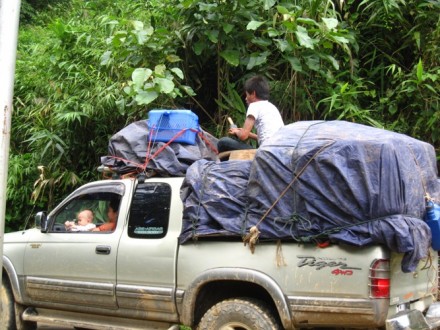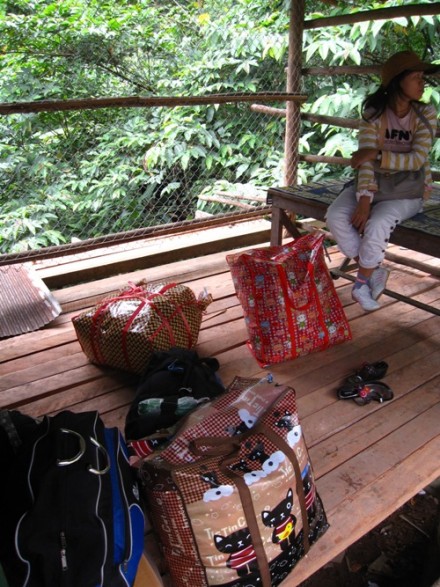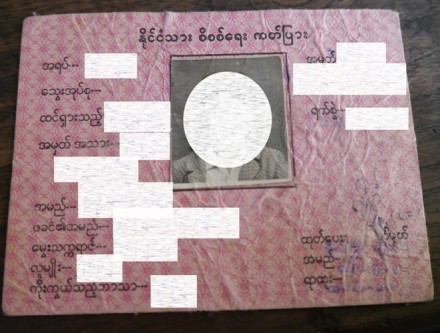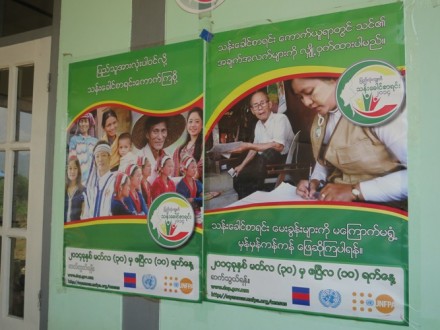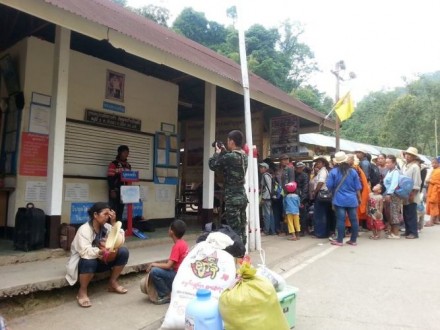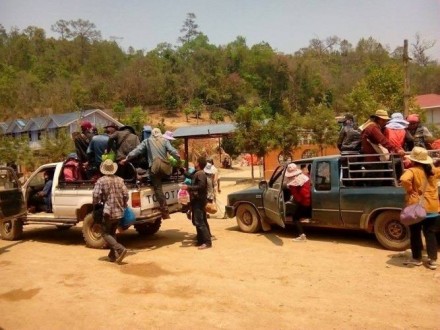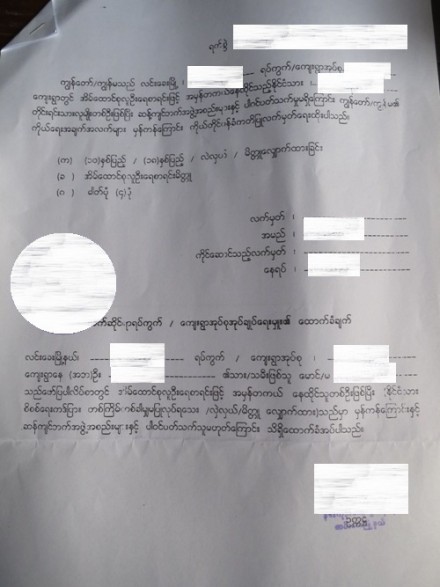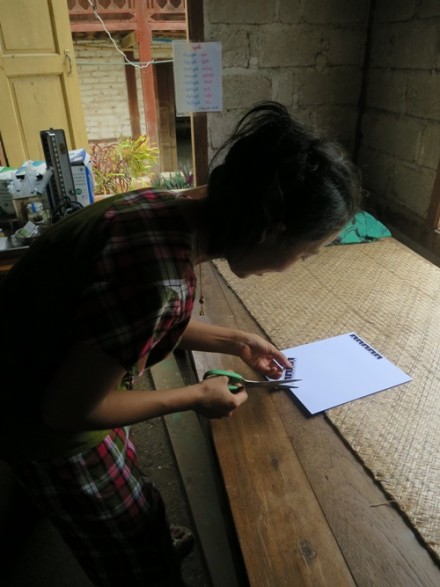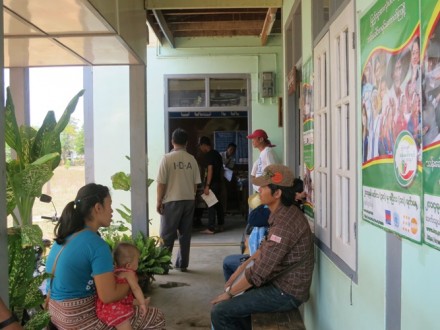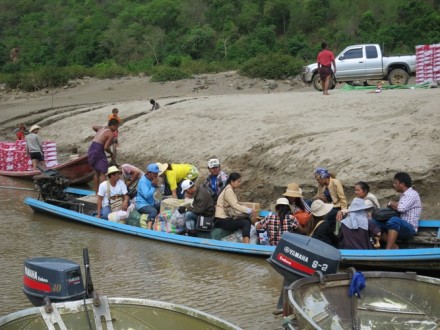Busarin Lertchavalitsakul charts Shan migrants’ experiences of ID card procurement and their mixed fortunes travelling between Thailand and Burma.
“I have been living in Thailand for more than 10 years, but I hold only a Bat Sib Pii, or ‘10-year-card’[1], so now I’m planning to go back to my hometown in Burma, to obtain a new Burmese ID card there. You know, in my hometown I have family land, and now in Burma there is so much development, so I’m thinking of going back and starting a farm on that land. Living here in Thailand I will never be rich; I can be only work as a wage laborer. Also, I won’t be granted Thai citizenship any time soon.”
This is the hope of Jai Toon (alias), a 44-year-old experienced teacher from a Shan village located on the edge of Shan State, near its border with Mae Hong Son Province in Thailand, and also the headquarters of the Shan State Army South (SSA-S), or Loi Tai Lang [2]. Currently, he makes a living as a painter, worker and supervisor on house construction projects, temple renovations and other, similar construction jobs. After quitting his teaching job in Shan State, he first lived in Mae Hong Son Province, northern Thailand, and now lives in the suburbs of Chiang Mai, where he works as a migrant laborer.
Jai Toon is among the many Shan short-term migrants who have been living in Thailand for more than a decade, and who have recently decided to go back to their hometowns to apply for a Burmese ID card. They were informed by their parents still in Shan State, fellow villagers and friends either by telephone, word of mouth or the television news about the ID card scheme in Burma. Sang Kam, a 34-year-old Shan domestic worker in Bangkok, revealed that her mother in Mork Mai Town, Shan State, asked her and her brother to go back home to apply for an ID card, which is also called a citizenship card or a security card. Her mother had been notified by the village headman that in 2015 the country planned to hold a general election, and as a result, villagers should inform family members working in Thailand to travel back home to obtain an ID card, by October 2014. “My brother and I were told that we need to vote for those representing Shan people. We hope that the election will bring the things Shan people hope and yearn for; including to be free of the Burman. Nonetheless, we still do not know exactly when the election will be held,” Sang Kham said.
These two cases highlight the information flows taking place between Shan migrant communities in Thailand and their hometowns, reflecting the widespread and strong transnational ties that exist across the border. Based on my interviews, there are two main reasons for them to visit their hometowns, both related to the improving political and economic situation in Myanmar over recent years. In light of the announcement of the impending ID card project, this year has witnessed a steady flow of Shan migrants from Thailand back to their homes in Shan State. As a consequence, Thailand has begun to face labor shortages, especially during long holidays, especially those during Songkran Festival (Thai New Year) in April, though this was not reported in the media. Many Shan migrants have recently started to plan a move home to Shan State, having not been there for several years or even a decade or more. During their time in Thailand, they have remitted money to their families and have kept in contact by telephone. Most Shan migrants choose the period between early March and the long Songkran holiday to visit their hometowns. This period coincides with an annual, traditional Shan event called Poi Sang Long, which involves the ordination of boys aged between seven and 12 years, and which can take place either in the home village or nearby. This event provides an opportunity for migrants to visit home and to meet their relatives and friends, as well as other villagers from different locations. This Shan ceremony is even more important for a particular Shan family when it is a son or other close relative who has been designated to participate in the event. If that is the case, the boy’s relatives are expected to help organise activities for both family members and the public. Therefore, this year, they would travel back home for two reasons; to attend the Poi Sang Long ceremonies, and to obtain a Burmese ID card.
Burmese ID card and the application process
Why is obtaining an ID card suddenly so important for the Burmese? One reason is that the government there is planning to hold a general election in 2015. At the same time, it has introduced a ‘smart citizenship card’ project, in order to further develop the ID card system, and this ID card is used to cast votes [3]. Once qualified to vote, Burmese citizens 18-years-of-age or over also then have to have an ID card. In addition to the election process, in 2011 the Immigration and National Registration Department in Burma announced its wish to improve the household registration process and population statistics, to raise standards in this area. The plan was to replace the old hand-written, pink printed card, with a black and white photo attached, with a digital card containing biographical and biometric data which could be scanned using a bar code [4]. However, the government did not follow-up on this plan; instead, a similar pink card is still used, but smaller than the former one. The new card can be conveniently inserted into a wallet, and uses thicker card which is not so easily torn or wrinkled.
The new ID card system was kicked-off during Burma’s 2014 nationwide census between the 20 March and the 10 April. It is the third census to have taken place; previous censuses were carried out in 1973 and 1983. Through the census and the ID card project, a lot of Shan migrants have taken the opportunity to claim their right to vote, as well as access resources in their home villages. Toon Ong (mentioned earlier) took the chance to register his name and household after losing his original household certificate a long time ago when moving to Thailand. He returned home in early 2014, at the time that government officers, under the census project, were coming to check and record the statistics for every household, to enter into the population system. They suggested he should apply for a new household certificate, but in the end he did not follow the official process, as he had no house and no immediate family members. Instead, he used the name of a dead person from a family in the village. The house owner had not declared that man’s death, so he was still recorded as alive on the system. As a result, Toon Ong simply replaced that man’s name with his own, and went to the district office to obtain a new ID card, with a new name and his photo on it.
Burma’s Citizenship Law of 1982 states that when Burmese citizens reach 10 years-of-age, they must apply for a citizenship card and renew it when they turn 18. It also says that those who do not apply for an ID card when they are ten must apply for one when they turn 18. Any citizens in these two categories must apply within one year of these dates at the immigration office within the township they reside. For those turning 10, they must present their birth certificate, household certificate and three photographs. At 18, they must be able to show their current ID card, along with a household certificate and three photographs. In cases where the card is lost or damaged, the card holder must apply for a new card at the same office, and have a police report along with two photographs. They must also pay a fee of ten Kyat for the replacement of the old card [5]. Many Shan migrants left home for Thailand at an early age, traveling with their parents before turning 10. Some left their hometowns after turning 10 and already had an ID card, but then did not return home before turning 18, when they were obliged to renew their citizenship cards, as they did not see any benefit to be gained from doing so. Some of them lost their cards soon after crossing the border from Burma into Thailand, mainly because they left their cards with the person who helped them cross, while others left their cards with relatives living in villages on the Thai side of the border. They believed at the time that carrying their Burmese ID cards would probably cause problems while living and traveling inside Thailand. Later, some applied for different types of non-Thai status cards in Thailand, in order to live there legally. Whenever they wished to go back to Shan State, they picked up their Burmese ID cards from their relatives at the border, in order to travel inside their home country. However, in practice, to hold a citizenship card was not important as a means of identifying oneself or for traveling; the card was used for other proposes by actors involved in the migration process.
Manipulation of the Burmese ID cards
In Mae Hong Son town, where I carried out my research, a number of Shan migrants whose hometowns are situated in southern Shan State use one particular crossing to enter Burma. This crossing is not a permanent border checkpoint, but is categorised by the Thai government as a crossing to be used for small-scale trade activities and for granting medication treatment as part of humanitarian aid among communities living on both sides of the border. However, unofficial immigration activities do occur at this crossing. This is a legacy of the commodity and people flows that have taken place since the pre-nation-state period, helped by the establishment of key Shan communities along the border since the post-colonial period and over the course of the insurgencies of the 1980s and 1990s. At this time, Khun Sa’sarmy occupied the township of Homong and other adjacent areas. Shan migrants in Thailand now use this channel to cross the border, as it is the closest gateway to their hometowns in southern Shan state. It is also the least problematic in terms of Thai immigration controls imposed by varying political entities on the Shan State side. The trip back home is facilitated by people living in border communities, especially those involved in cross-border transportation and small-scale trade activities, as well as Shan kin-based networks. Shan people can therefore travel from one side of the border to the other using pick-up trucks that operate on both sides. On the Thai side, pick-up trucks that run between Mae Hong Son town’s central market to the border are operated by a group of 24 truck drivers who were once trans-border traders, both before and during Khun Sa’s rise to power. They still have business connections and capital needed to be able to operate the truck system, despite being regulated by the provincial public transport office in Mae Hong Son. On the Burmese side, there is no state-regulated public transport system, so border crossers depend on an unofficial pick-up truck system regulated by the Wa family, which controls an area from the international border to the east bank of the Salween River in southernmost Shan State. The Wa family’s members are relatives and descendants of two brothers: Mahasang and Mahaja, who were once aids to Khun Sa, before Khun Sa turned himself to the Burmese army. The Wa insurgent group later led by Mahaja agreed a ceasefire with the Burmese government and negotiated zones of control around the border. To travel to Shan State, passengers must give their Burmese citizenship cards to the truck drivers or owners as they travel, in order for the drivers to be able to show ID cards at different posts along the route operated by the Wa family, the Burmese military, and Burmese police officers. It is clear that a Burmese ID card is not used to identify a traveler’s status, but as a thing the Wa family and Burmese officers can use to count the number of passengers in each truck; to illegally extract money from them, in the form of deductions taken from the fares they pay to the truck drivers.
Why is this border crossing seen as less problematic for the Shan migrants, especially those who have no Burmese ID cards? It’s because it is located in southernmost Shan State, where the Wa family uses its own militias to exert control and run both legal and semi-legal businesses. The main administrative office is in Homong, where officers can issue a document which acts as a travel pass and is equivalent to an ID card for people who lack others forms of ID, for a charge of 200 Thai Baht. The Wa family-controlled area has used Thai Baht as its principle currency for a number of decades. Nonetheless, there is another way to travel legally in Burma without paying 200 Baht to the Wa family; one can simply ask for an ID card from your pick-up truck driver on the Thai side. These ID cards belong to Shan people who can no longer be contacted or left their ID cards behind after arriving in Thailand a long time ago. It was not easy for me to find-out how the truck drivers collect these ID cards, but what I realised is that they own about 10 to 20 cards, from which Shan migrants can choose one on which the photo looks most like them. The most important thing after finding the best card is to be able to remember the name of the card’s former owner and their father’s name. The Burmese citizenship card is peculiar in terms of the information and details it holds. As well as common details such as name, ID card numbers, height, blood type, and an issue date; some information, such as the father’s name and the card holder’s birth marks or rare features, ethnicity, and career must also be stated. As a consequence, people who use other people’s citizenship cards must memorise the father’s name very carefully, as it is information the Burmese border officers require. Moreover, on the back of the card, three statements are written. First, a card holder must carry a citizenship card at all time. Second, if losing the card, the card holder must report either to police officers, immigration officers, or district officers in where the card holder reside. And third, in the case of the card’s loss or damage, the card holder must be fined.
From the current situation, Shan migrants who have lived in Thailand for a long time consider obtaining an ID card very different to before. This year, some Shan migrants have travelled back home to apply for an ID card; while many have taken their children born in Thailand back home to be issued a citizenship card as well. This was unexpected, as Shan migrants have tried hard to settle in Thailand over the years, rather than return to Burma. Those who had children in Thailand and were well informed realised they had to obtain a birth certificate from the hospital where the baby was born. Therefore, their children could have access to some of the benefits and welfare measures offered by the Thai state, or even try and get Thai citizenship for their child. However, rapid changes inside Burma have begun to alter their perspectives. They acknowledge that there is now a freer political climate, resulting in a better chance of making a living, partly from increasing foreign investment. They are also hopeful the country will become more developed and create job and work opportunities at home. Another economic attraction for them is the formation of the ASEAN Economic Community (AEC) officially implemented in 2015, which intends to free-up international trade in the area, leading to the possibility of being able to move back and forth between Burma and Thailand.
Inevitable costs of procuring an ID card
When applying for a citizenship card, Shan migrants who still have their names recorded on a housing certificate do not face any difficulties. However, they must present a signed confirmation letter issued by a sub-district chief or Poo Haeng, that they indeed are members of any village in that sub-district and in the country. This certified document is called Toak Khan Za in Burmese. Automatically, Shan migrants’ parents whose names are recorded on the family’s housing certificate can also have any children of theirs born in Thailand registered for a Toak Khan Za by the Poo Haeng.
The application process for a Burmese ID card can be inexpensive or costly depending on the situations and what connections the applicants have with governmental officers, particularly those who work at the ID card issuing office. Although the government has declared that the cost of a digital citizenship card is about 1,000 Kyat or 1 US Dollar, excluding the cost of three photographs required [6]. This does not reveal the other, customary costs involved in the process, especially at the village and sub-district levels. First, applicants must have three 0.5 x 0.5 cm black and white photographs of themselves ready. Normally, they will have the photos taken in their villages or nearby, in order to save time when processing at the district office. In one Shan village named Kongna (pseudonym) where I spent time, most people got their photos from a person who owned a digital camera and a printer, to be able to process acceptable quality photos at home rather than at a professional photo lab or studio. People who own such equipment are normally state officials rather than farmers or other ordinary villagers. In the village I stayed in, ladies called Sayama (a teacher) and Samasamkhem (a vaccination nurse) provided these photos at a cost of around 1,000 Kyat for six.
After obtaining a photograph, applicants must go to the Poo Haeng to obtain the Toak Khan Za mentioned above, with the charge of 2,000 Kyat. The person applying for the letter might be asked by the sub-district chief about his/her father’s name. From there, they go to the district office by themselves or accompanied by someone who is able to help them communicate in Burmese.
Most Shan migrants who left Burma decades ago cannot speak Burmese, at least not well enough to interact with state officers. In very special cases, a person might ask a village headman or Poo Gang to accompany them and facilitate the process. Next, the applicant has to pay 2,000 Kyat to a sub-district police officer and another 2,000 Kyat to a sub-district or district hospital, to confirm that they are healthy, although the hospital does not carry out a physical examination.
On the day I observed the procedure, the village headman of Kongna brought a Shan man who had been living in Mae Hong Son to apply for a Burmese card. He was actually not a Burmese citizen, although he had some relatives in the village. Some people revealed that he was really Thai, but a Shan ethnic who wanted a Burmese ID card in order to take advantage of opportunities brought by the AEC and economic speculation in Burma. In order for a village headman to support an application, some reciprocity must take place; such as treating the headman to lunch at a good restaurant with beers or other alcoholic drinks.
The process to me seemed quite unclear, because the village headman and the man from Mae Hong Son did not go directly to the district office; they drove a motorcycle past the office and stopped in the district’s market area. The village headman prepared some documents written in Burmese, and then asked the man whether he had a birthmark or a scar, and if so on which part of his body, information required for the card. After this, the Poo Gang told the man that he must go to a meeting, where his application would be considered and approved. It was still unclear what was happening, and when I asked for clarification I only received vague answers. Around half-an-hour later, the village headman came back and told the man to go to the district office, which was about two kilometers from the market. The men then stopped on the other side of the road, in front of the district office. The Poo Gang sat on the ground under a tree and checked all the documents one more time. Another man was already sitting there, and helped the Poo Gang arrange the papers in the proper order. It seemed they were very carefully carrying out the process; to me it certainly did not look like a normal ID application process.
Soon after, the village headman and the applicant walked to the district office to start the procedure. People were sitting in front of the room where officers processing the ID card application, waiting for their height to be measured on a pole, after which they handed in all their documents to the officers. They then had to wait for an officer to record their fingerprints using black ink; these being recorded on papers. Then they had to wait for a few more hours before adding their left thumbprint to the card, after which it was coated in plastic to protect it from damage or from being tampered with. Finally, the process was complete and the applicant paid the fees required. Sang Kam explained:
“Normally, at the district office we have to pay no more than 3,000 Kyat, but I paid 10,000 Kyat because I asked someone who spoke Burmese to help with the entire process. I know parts of this amount went to the police and the hospital for some documents. But I didn’t wait so long, just two or three hours, because it was not the peak season. Nonetheless, I spent the whole day on the process. I know many people paid extra to move up the queue, so they did not have to wait so long. My brother paid 12,000 Kyat during the peak season, and I have heard of some people spending 40,000 Kyat to get a card without having to wait at all.”
Ple (an alias), a 34-year-old Shan woman who has a Thai food stall in Chiang Mai, Thailand, told me of her experience when traveling from her Shan village to the Thai border. She said the fees paid to obtain a Burmese ID card at the district office varied for each individual. I asked many people what the official fee was, but never got the same amount. The average amount seemed to be between 10,000 and 12,000 Kyat, excluding 2,000 Kyat for the sub-district headman and the photographs.
Become a “citizen” or be treated as a “subject”
In early March to April this year, during the peak traveling period, nearly 400 to 500 people crossed the border from Mae Hong Son in Thailand into southern Shan State in Burma, a large number when compared to the previous year at the same time (around 200 to 300 people). As a result of this increased demand, an large number of trucks, both registered and driven by individuals, were called into service, especially to drive the route from towns located on the western side of the Salween River to its banks, where people transferred on to a ferry. Normally only registered vehicles can take passengers from the Thai border, but this year extra trucks were temporarily allowed by the Wa family to meet the increased demand for vehicles from Shan migrants returning home to obtain their citizenship cards. Meanwhile, in Kongna village, which is located on the main road to cities further inside Shan State, local officers called Pyi Thu Gyi in Burmese, whose duty was to protect the village, charged unreasonable, additional fees of 2,000 Kyat for each traveler who stopped in or passed through the village. Villagers said that the Pyi Thu Gyisaw the opportunity to extract money from the large numbers of people returning home. Without question, these travellers had to pay the fees and follow the arbitrary rule.
Another notable aspect was the interactions and relations in place between the local officers and villagers. As mentioned earlier, the Poo Haeng is a local political figure who has had a lot more power granted to him by the ID card application process. Without his signature on the documentation, a person cannot obtain an ID card. La Miew told me a story about her father that highlighted the interrelations between the Poo Haeng and the villagers. The difficulty with this case started because her father had two different names. One of these names was a Shan name, the name he was usually called by, while the other was his official Burmese name, as used in the official documents such as his household certificate. He applied for a new Burmese ID card by getting the tao kam ja, or a village membership certified document, from the Poo Haeng. However, when he tried to process the application at the local office, his case was rejected because his Shan name was on the housing document, while his Shan name was written on the document signed by the Poo Haeng. As a result, he had to go to the Poo Haeng again and ask him to write another letter, this time stating that the man whose names appeared in the documents with both Shan and Burmese was in fact the same person. The Poo Gang is another powerful figure within the ID card application process, well demonstrated from the Poo Gang in Kongna village who helped the man from Mae Hong Son finally obtain an ID card. At the district office, he asked one district officer to prepare the documents, and finger printed them himself; something which seems to be normal, though the village headman was not supposed to do this. The power of the village headman within the local political scene can be traced back to before the British colonised Burma. Van Schendel (1987: 458) states that a village headman at that time functioned as a “broker” between royal officials and commoners in several ways, collecting tributes, maintaining the list of farmers on land seen as royal property, and acting as a policeman, adjudicating on small disputes between commoners [7].
Ple’s story also signifies how villagers are treated as ‘subjects’ within the ID card application process. She had to go to the district office three times. The first time, she found out that the person normally in-charge of the process had left to take up a position at a temple, and that without him present, others could not sign-off on the process. On the second occasion, the new officer had gone to run some errands in another town. Although the third visit was successful, Ple had to drive a motorcycle, with her brother, to the district office, a trip which took about an hour. The bureaucratic and local political systems in rural Burma still treat people as ‘subjects’, leading to a paradox in which people are now turning into citizens while at the same time still being treated as subjects. While Shan people have decided to return home to obtain citizenship and claim their political right to vote, these are also duties enforced upon them by the Burmese government at the national level. What the Shan people have encountered, in order to go through the citizenship process at the local level, and by interacting with local political figures like Poo Heang, Poo Gang, and other officers, demonstrates how they are still being subjugated by customary practices embedded in the local bureaucratic system by powerful political figures. Hence, for Shan migrants, the process of becoming a citizen can be seen as confirming their national status, as belonging to the one nation state. The notion of citizenship from this perspective can be seen as showing that they belong to the state, in other words, the term ‘citizenship’ can be used interchangeably with the term ’nationality’ [8].
Dual ID Cards and repercussions of the 22 May Coup in Thailand
People around Mae Hong Son town and in southern Shan State have long benefitted from cross-border flows and activities. People could cross the border fluidly and flexibly due to loose immigration control on the Thai side, and the arbitrary administration imposed by the Wa family. As a consequence, people have used and manipulated the border regulations in place to facilitate their migration and commodity flows. Many Shan people travel from Shan State to Mae Hong Son on a short- or long-term basis, while many also go further to find jobs in other parts of Thailand. Many Shan who migrated to Thailand a few decades ago have different status cards as issued by the Thai state. Nonetheless, they have always retained their pink Burmese ID cards.
In the meantime, Shan-Thais who live and make a living along the border, have also recently looked for a way to procure a Burmese ID card; also for their own children born in Thailand. This group of people always tends to prepare in advance to account for the changing border situations, and especially in anticipation of the AEC being introduced in 2015. Truck drivers and traders on the Thai side use their personal connections to obtain Burmese citizenship cards, while others have bought land from local people at a low price, with no plans to develop it. The land registration process is not problematic for them, as long as they have good connection and capital to invest.
The number of Thai people who wish to obtain Burmese ID cards has visibly increased since the ID card project was launched by the Burmese government. Homong was the first place applicants went in search of help; either to ask local political officers such as the sub-district headman to confirm their residence status in local villages, or to use deceased or missing persons’ identities as their own. This latter process is possible as Shan people, even if alive, may not have contacted their families in Shan State for a very long time, meaning their families may have already organised a wake by lighting joss sticks and calling for the missing persons’ names to return home or to make contact with their families.
These families may have waited for years, until they finally believed the missing person had died in Thailand and could no longer make contact. Some ‘missing’ Shan people even decide not to return to Burma; instead they settle in Thailand due to various circumstances. For instance, they have been granted Thai citizenship through marrying a Thai; they bought houses and established their own businesses; and their children go to school in Thailand. The families of such people often let other people use the citizenship cards left behind, providing opportunities for Thai people, especially in the border communities, to be able to obtain a Burmese ID card.
A few months ago, a rumor spread that the Homong administration was to issue a maximum of only 100 cards a month. The flock of applicants exceeded the quota for this township to issue ID cards. As a result, many Thai people switched their registration locations to other border villages located in different sub-districts. Nonetheless, it is very difficult for those in the border communities to predict the situation on the ground, particularly since the coup that took place on 22 May in Thailand, when the military seized power in Bangkok.
Once this happened, all border crossings were immediately closed for at least a week, after which the Thai government ordered a local military base on the border crossing in Mae Hong Son to open three days a week. It is now fully open due to a request made by the Wa family, because when the crossing was closed, those on the Shan State side were running out of food and other goods. Amid this tense situation, border villages have been visited by military officers. One shocking event for people was one Thai truck driver charged with having a Burmese citizenship card at home, as dual citizenship is not allowed. A rumor spread that the truck driver had to bribe the Thai officers with an amount of 20,000 Baht, so they would not file a lawsuit against him. He chose not to be in a trial, so paid a bribe to have the charges dropped instead.
Meanwhile, some powerful Shan figures with dual citizenship have avoided crossing the Thai border, for fear of being targeted, charged or arrested by Thai officers. As a result, Shan people who have been granted legal status by the Thai government are now in panic, and hide their Burmese ID cards for fear of being fined or punished, and especially of being deported back to Burma. One Shan woman who has been migrating to Thailand for more than 20 years and now has a house in a border village, revealed her feelings on this issue:
“I don’t know what is going to happen to us. If the Thai military officers find our Burmese ID cards, they may no longer allow us to stay here, because we have to follow Thai law. We still want to live in Thailand, although I was granted only highlander status. Nonetheless, I cannot abandon my Burmese citizenship either. I don’t know yet where my family and I will be living in the future. We might go back home if the situation inside Burma improves.”
Busarin Lertchavalitsakul is a PhD candidate at the Amsterdam Institute for Social Science Research, the University of Amsterdam. Her research focuses on the interplay between Shan people’s migration and commodity flows around the Burma-Thailand borderland.
——————————-
[1] This card is officially called Bat Poo Mai Mii Sthana Tang Tabien, and is given to those who are considered by the Thai state as “stateless persons”, and will either be granted Thai citizenship in the future, or deported back to their home countries. The card expires after ten years, and it allows people who enter Thailand to reside legally.
 Facebook
Facebook  Twitter
Twitter  Soundcloud
Soundcloud  Youtube
Youtube  Rss
Rss 
